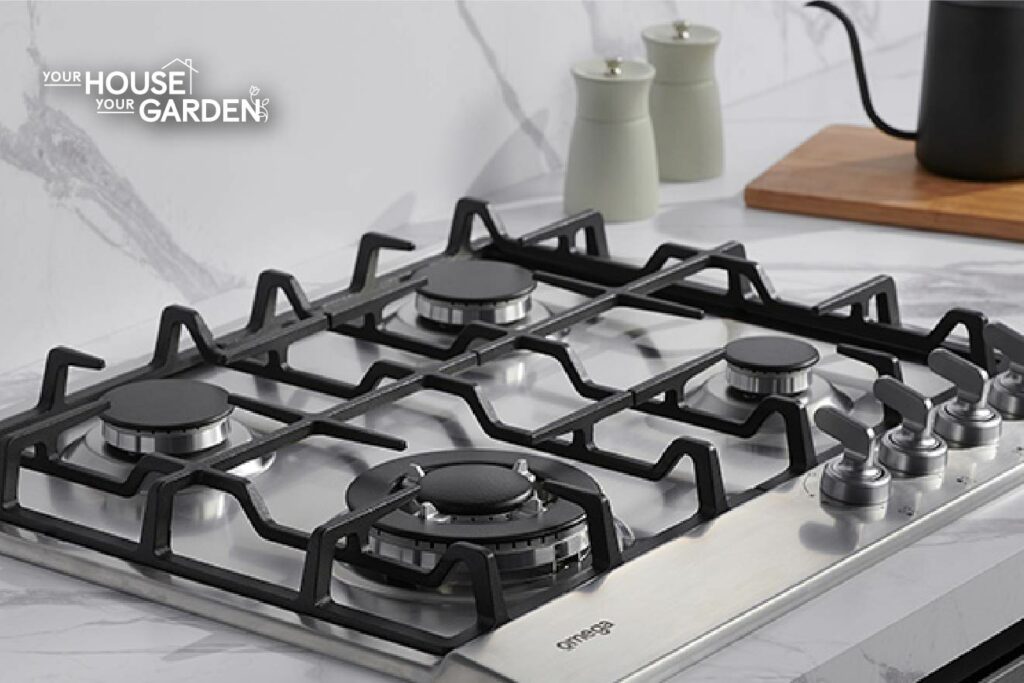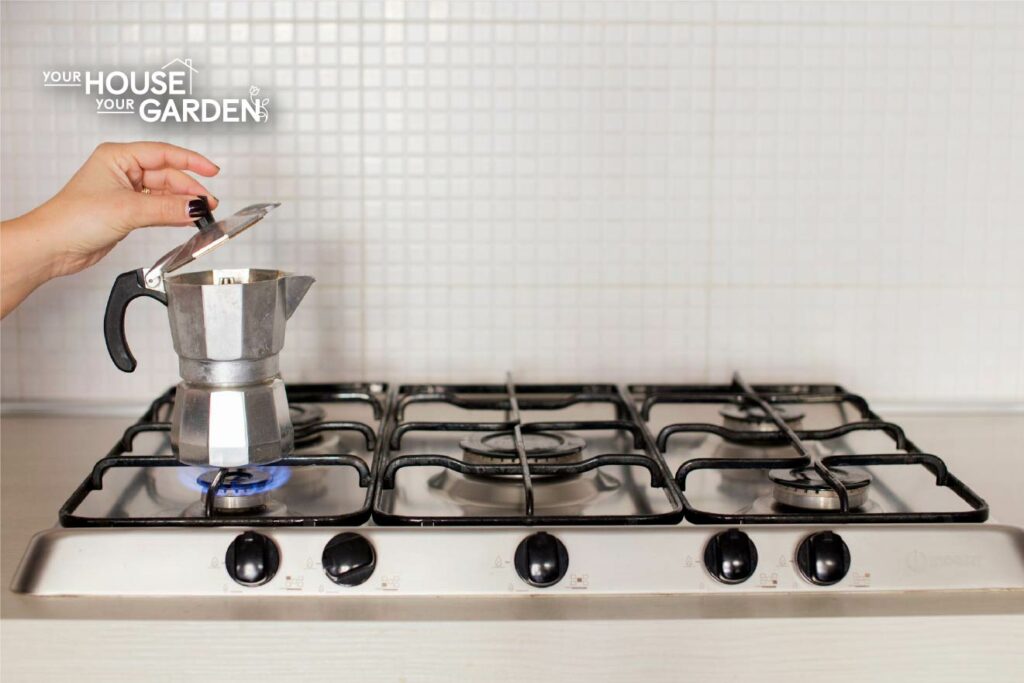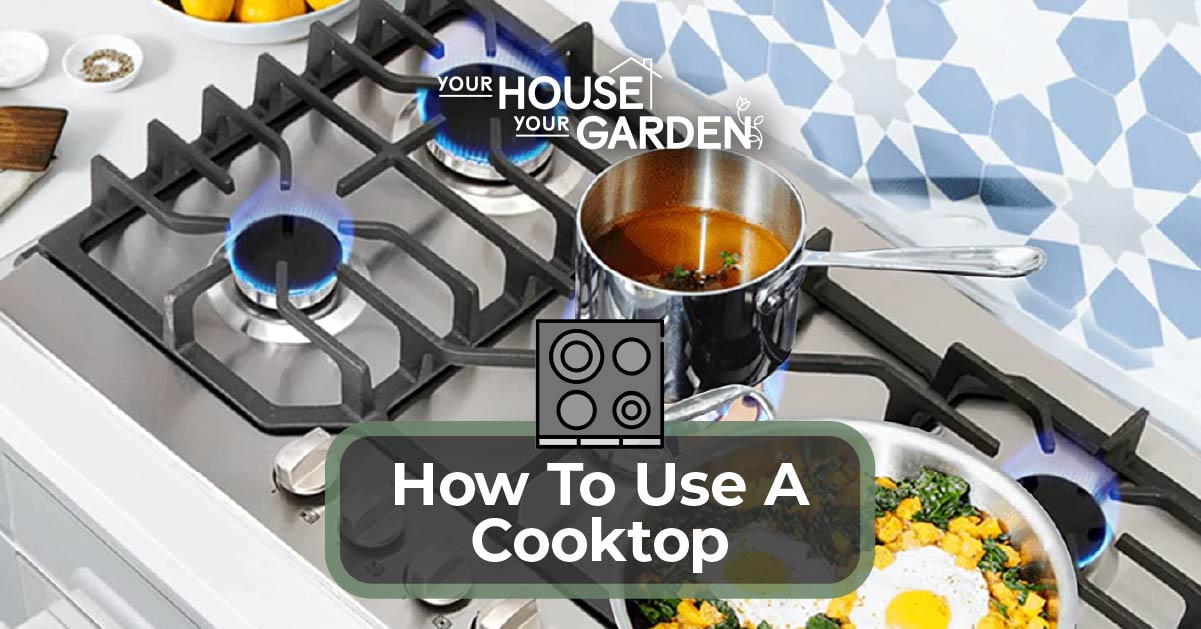Using a cooktop involves the following steps: turning an element on, placing your cooktop-friendly pot/pan on the element, adjusting the temperature, cooking for food, and cleaning the cooktop and pan.
What is a cooktop? A cooktop is a kitchen appliance used for cooking food and boiling water. Most cooktops use induction for heating, but gas and electric models are also popular.
If you’d like to learn more about how to work a cooktop, refer to our in-depth cooktop usage guide below.
1. Pick Out Your Cookware
What kind of cookware you use will depend on what type of cooktop you have. While nearly all types of pots and pans will work with gas or electric cooktops, this isn’t the case with induction cooktops.
If you’re using an induction cooktop, you’ll need a pot or pan with some iron in the base for it to heat up. Induction works by transferring energy into iron, which creates heat. Because of this, Aluminum, Copper, Clay, and glass cookware can’t be used on induction stove tops.
Conversely, cast iron, enameled cast iron, carbon steel, and most stainless cookware can be used with induction stove tops.
2. Choose Element and Turn Cooktop On
Which element you choose will depend on what model of cooktop you have and the size of pan you’re using. Some cooktops come with a single element/burner, meaning you don’t have any choice in the matter.
Other cooktops have three or four elements of varying size. When choosing an element, use the one that best matches the diameter of the pot or pan you’re using.
How you turn your cooktop on or off will depend upon what type and model you have. For electric cooktops, simply push the on button corresponding to the burner you want to use. With gas-powered burners, most employ a set of dials, each one operating a different burner.
To get the gas flowing, turn the dial counter clockwise using the built-in lighting mechanism to light the flame.
The interfaces for Induction burners can vary quite a bit, but they all come with an on switch and some way to adjust temperature. Remember, induction cooktops won’t heat up unless a piece of cookware has been placed on an element.
3. Start Cooking
When the pan has warmed up, you can start cooking. Most people start by adding a tablespoon or two of oil before placing their ingredients into the pan.
4. Clean Pots and Cooktop
When you’re done cooking, it’s time to clean the cookware and cooktop. If you’re using an aluminum pot or pan, they can be placed directly into the dishwasher or hand washed with hot water and dish soap. Cast iron pans can’t be placed into the dishwasher and can’t be cleaned using hot water and dish soap.
To clean your cooktop, make sure the appliance has been switched off and has fully cooled down. From there, take a wet cloth or cleaning rag and wipe down the surface. If you have a glass-topped induction cooker, consider buying a bottle of glass top cleaner and polish.

Cooktop Using Tips for Efficiency and Improved Taste
When using an induction cooktop, there are a few tips and tricks you can use to improve efficiency, the most important being:
Don’t Let Glass Top Overheat: If you’re using an induction cooktop, don’t let it overheat as this could cause the glass to crack. To avoid this, don’t let the cooktop run for several hours. Induction cooktops are not as resilient as gas cooktops.
Hire A Professional for Repairs: If your cooktop breaks down or needs repairs, don’t try and fix it yourself. This is especially true with induction cooktops as they employ complex electric and electromagnetic systems.
Be Careful With Cast Iron: If your cooktop has a glass surface, like many induction cooktops do, be careful when using cast iron cookware. Cast iron has a tendency to scratch the glass when dragged.
Clean Gas Cooktops regularly: Because of their design, it’s common for oil to build up on the surface of gas cooktops. If too much builds up, it can pose a fire hazard.
Main Steps and Mistakes for When Using a Cooktop
Using a Cooktop can be broken down into the following steps:
- Prepping your food and choosing the appropriate cookware.
- Turning the cooktop on and placing your pot/pan on the appropriate burner/element.
- Cook your food.
- Clean the pot/pan and wipe down the cooktop.
When using a cooktop, there are several mistakes to watch out for, including:
- Letting food residue build up on the cooktop surface.
- Using sharp objects to remove caked on food.
- Not attending to burner blogs on gas cooktops.
- Using coarse or steel wool sponges to clean the cooktop surface.
- Using a cleaner while the stove is still hot.
- Storing heavy items on top of the cooktop. The average cooktop can only support 50 pounds.
Most of the best cooktops come with different sized burners/elements. For best efficiency, always choose the element that best fits the diameter of the cookware you’re using.
Does the Cooktop Types Affect the Usage Stages
Yes, the cooktop type affects the usage stages. To understand how, we must first look at the different cooktop types.
Gas Cooktops: Gas cooktops use propane or natural gas as a heat source. Most gas cooktops have porcelain enameled cast iron grates as a cooking surface. Many gas-powered cooktops are portable, making them convenient.
Electric Cooktops: Electric cooktops use electricity to produce heat. Unlike gas-powered cooktops, electric models feature flat cooktops.
Induction Cooktops: Similar to electric cooktops but use induction heating as a heat source. Induction heating works by creating an electromagnetic field. When this electromagnetic field comes into contact with conductive materials, heat is produced.
Ranges: A range is a large household appliance that comes as an oven and cooktop combo.
The usage stages for all four types of cooktops are nearly identical and the only major difference is the temperature controls they come with. For example, gas and electric cooktops typically use dials while induction cooktops normally come with buttons.
When to Prefer Cooktop Over Stovetop
When it comes to the question of cooktop vs. stovetop, there isn’t much difference between the two and both serve the same function. That said, depending on the size of your kitchen, ranges may be too bulky and may take up too much space.
Cooktops can be installed nearly anywhere and are a good fit for the space-conscious individual. Additionally, cooktops are better suited to outdoor kitchens.

Alternative Uses of a Cooktop for Other Uses Besides Frying Food
Cooktops can be used for a variety of uses that go beyond just frying food. To learn more about the different cooktop uses, refer to the sections below.
Use a Cooktop As a Microwave
You can’t use a cooktop as a microwave. Microwaves use electromagnetic radiation to excite water molecules in food, which results in heat. By contrast, cooktops use a direct heat source.
That said, you can still reheat leftovers using a cooktop by placing the food in an appropriately sized pan and placing it on top of an active burner/element.
Use a Cooktop as a Gas Stove
Cooktops can’t be used as a gas stove. Gas stoves come with settings that allow you to change how heat circulates in the stove. This type of feature isn’t available on cooktops as heat can only be applied to the bottom of the cookware.
However, you can somewhat mimic the effects of a gas stove by using a large cookpot with the lid on.
Use a Cooktop as a Soup Maker
To use a cooktop as a soup maker, follow these steps:
- Prepare ingredients and put them into a large cookpot with water.
- Turn on the largest element and place the cookpot on top.
- Place the lid on top.
- Stir regularly.

